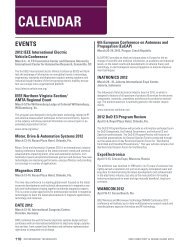2011 EMC Directory & Design Guide - Interference Technology
2011 EMC Directory & Design Guide - Interference Technology
2011 EMC Directory & Design Guide - Interference Technology
You also want an ePaper? Increase the reach of your titles
YUMPU automatically turns print PDFs into web optimized ePapers that Google loves.
standards<br />
O n t h e N at ur e a nd Us e of t h e 1.04 m El e c t ric Fiel d Probe<br />
Figure 4a. Rf potential on radiating wire<br />
loaded by 50 Ohms. Span is 2-32 MHz,<br />
reference is 10 dBm, 10 dB per division<br />
(-10 dBm = 97 dBuV).<br />
Figure 4b. Radiated signature using Figure 3a antenna configuration, scanning 2-32 MHz,<br />
reference level is – 30 dBm. For picture on left, coax connection to chamber was 12 feet, on the<br />
right it was 24 feet. Uncorrected data; field intensity would be 8 dB higher than levels shown.<br />
analyzed. The analysis follows that for the traditional set-up,<br />
except that the limits of integration are from the base of the<br />
rod 12 cm above ground to 1.04 meter above that – there is<br />
no need to break the integral into different parts, because<br />
the vectors now all have the same sense with respect to each<br />
other over the entire rod length.<br />
Per drawing 2e we integrate directly from the base at 12<br />
cm above ground to the top of the rod at 1.04 meters plus<br />
12 cm. Note that this makes the limits of integration 7 cm<br />
to 1.04 meters plus 7 cm, because our zero point is the wire<br />
above ground height of 5 cm.<br />
50.7 dBuV/m, and the EMI receiver will read -64.3 dBm.<br />
Analytical results for the three measurements of the same<br />
radiating wire are compared to measurements presented in<br />
section IV. Analytical and measured results for all methods<br />
agree well, except for resonances, which is why the MIL-<br />
STD-461F approach came about.<br />
Drawing 2e. More exact simulation<br />
of Figure 3a.<br />
Equation 6g evaluates the contribution from the above<br />
ground wire as 938 uV. Equation 6i evaluates the contribution<br />
from the image wire as -1282 uV. The net result is -344<br />
uV, or 50.7 dBuV. This means an effective field intensity of<br />
*antenna base on top of ground plane<br />
**from section IV measurements section<br />
*** absent resonances<br />
Table 1. Comparison of analytical and measured results.<br />
The analytical results make the following issues clear:<br />
the calculation of rod-coupled potential does not depend on<br />
counterpoise configuration. It was not discussed previously,<br />
but the only purpose of the counterpoise is to achieve the 10<br />
pF source impedance of the 1.04 meter rod. Absent a counterpoise,<br />
that value decreases markedly. A counterpoise is a<br />
reference against which the rod antenna induced potential<br />
Figure 4c.<br />
Counterpoise potential<br />
and rod antenna<br />
output super-imposed.<br />
Ground plane potential<br />
is the curve that is<br />
lower at the low end<br />
and higher after 14<br />
MHz (2-32 MHz sweep,<br />
17 MHz at center).<br />
Figure 4d. Impedance<br />
between floor<br />
and counterpoise<br />
of MIL-STD-461F<br />
configuration w/o rf<br />
sleeve.<br />
74 interference technology emc <strong>Directory</strong> & design guide <strong>2011</strong>


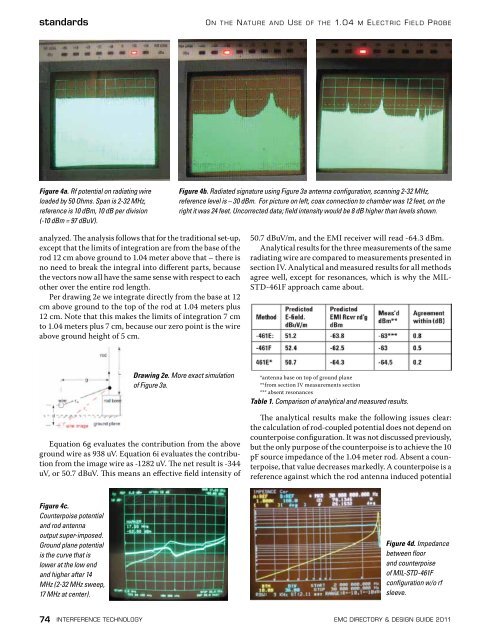

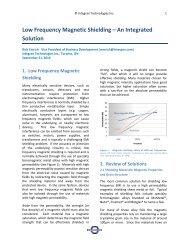

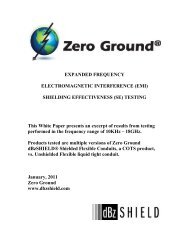
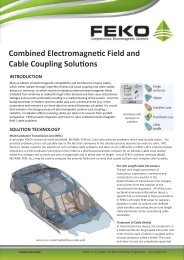



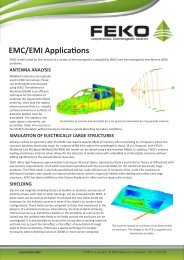
![[ thursday ] morning sessions 8:30 am-noon - Interference Technology](https://img.yumpu.com/23176841/1/190x247/-thursday-morning-sessions-830-am-noon-interference-technology.jpg?quality=85)
